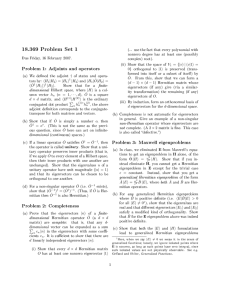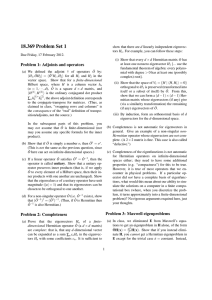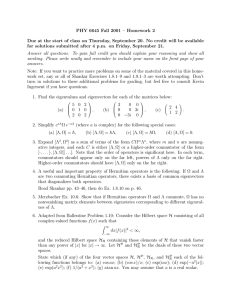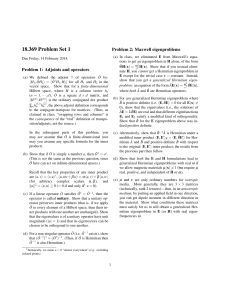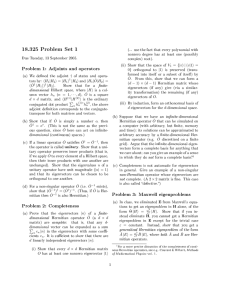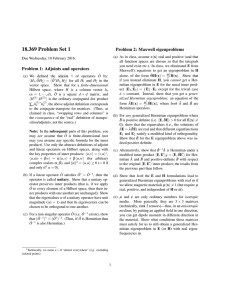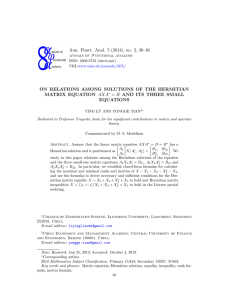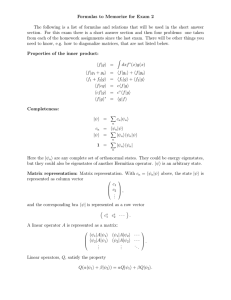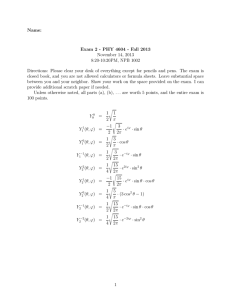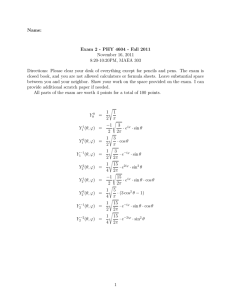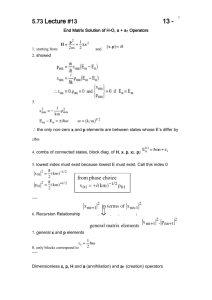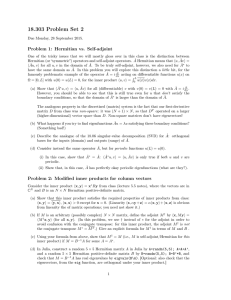18.369 Problem Set 1 Problem 1: Adjoints and operators
advertisement
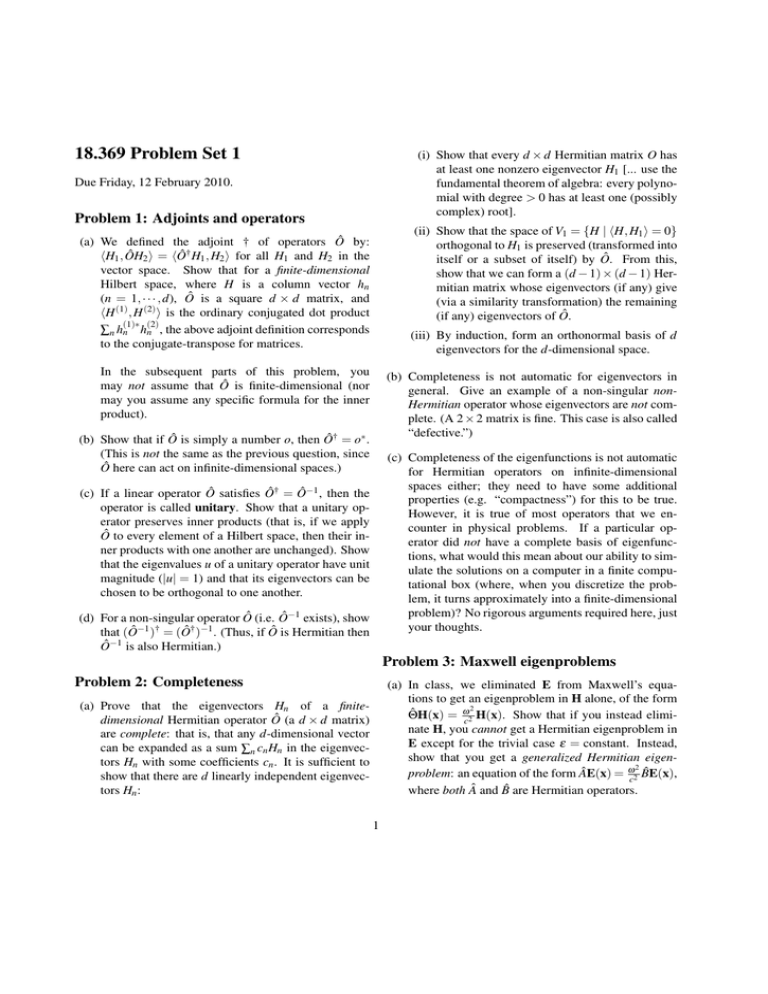
18.369 Problem Set 1
(i) Show that every d × d Hermitian matrix O has
at least one nonzero eigenvector H1 [... use the
fundamental theorem of algebra: every polynomial with degree > 0 has at least one (possibly
complex) root].
Due Friday, 12 February 2010.
Problem 1: Adjoints and operators
(ii) Show that the space of V1 = {H | hH, H1 i = 0}
orthogonal to H1 is preserved (transformed into
itself or a subset of itself) by Ô. From this,
show that we can form a (d − 1) × (d − 1) Hermitian matrix whose eigenvectors (if any) give
(via a similarity transformation) the remaining
(if any) eigenvectors of Ô.
(a) We defined the adjoint † of operators Ô by:
hH1 , ÔH2 i = hÔ† H1 , H2 i for all H1 and H2 in the
vector space. Show that for a finite-dimensional
Hilbert space, where H is a column vector hn
(n = 1, · · · , d), Ô is a square d × d matrix, and
hH (1) , H (2) i is the ordinary conjugated dot product
(1)∗ (2)
∑n hn hn , the above adjoint definition corresponds
to the conjugate-transpose for matrices.
(iii) By induction, form an orthonormal basis of d
eigenvectors for the d-dimensional space.
In the subsequent parts of this problem, you
may not assume that Ô is finite-dimensional (nor
may you assume any specific formula for the inner
product).
(b) Completeness is not automatic for eigenvectors in
general. Give an example of a non-singular nonHermitian operator whose eigenvectors are not complete. (A 2 × 2 matrix is fine. This case is also called
“defective.”)
(b) Show that if Ô is simply a number o, then Ô† = o∗ .
(This is not the same as the previous question, since
Ô here can act on infinite-dimensional spaces.)
(c) Completeness of the eigenfunctions is not automatic
for Hermitian operators on infinite-dimensional
spaces either; they need to have some additional
properties (e.g. “compactness”) for this to be true.
However, it is true of most operators that we encounter in physical problems. If a particular operator did not have a complete basis of eigenfunctions, what would this mean about our ability to simulate the solutions on a computer in a finite computational box (where, when you discretize the problem, it turns approximately into a finite-dimensional
problem)? No rigorous arguments required here, just
your thoughts.
(c) If a linear operator Ô satisfies Ô† = Ô−1 , then the
operator is called unitary. Show that a unitary operator preserves inner products (that is, if we apply
Ô to every element of a Hilbert space, then their inner products with one another are unchanged). Show
that the eigenvalues u of a unitary operator have unit
magnitude (|u| = 1) and that its eigenvectors can be
chosen to be orthogonal to one another.
(d) For a non-singular operator Ô (i.e. Ô−1 exists), show
that (Ô−1 )† = (Ô† )−1 . (Thus, if Ô is Hermitian then
Ô−1 is also Hermitian.)
Problem 3: Maxwell eigenproblems
Problem 2: Completeness
(a) In class, we eliminated E from Maxwell’s equations to get an eigenproblem in H alone, of the form
2
Θ̂H(x) = ωc2 H(x). Show that if you instead eliminate H, you cannot get a Hermitian eigenproblem in
E except for the trivial case ε = constant. Instead,
show that you get a generalized Hermitian eigen2
problem: an equation of the form ÂE(x) = ωc2 B̂E(x),
where both  and B̂ are Hermitian operators.
(a) Prove that the eigenvectors Hn of a finitedimensional Hermitian operator Ô (a d × d matrix)
are complete: that is, that any d-dimensional vector
can be expanded as a sum ∑n cn Hn in the eigenvectors Hn with some coefficients cn . It is sufficient to
show that there are d linearly independent eigenvectors Hn :
1
(b) For any generalized Hermitian eigenproblem where
B̂ is positive definite (i.e. hE, B̂Ei > 0 for all E(x) 6=
01 ), show that the eigenvalues (i.e., the solutions of
ÂE = λ B̂E) are real and that different eigenfunctions
E1 and E2 satisfy a modified kind of orthogonality.
Show that B̂ for the E eigenproblem above was indeed positive definite.
(c) Show that both the E and H formulations lead to
generalized Hermitian eigenproblems with real ω if
we allow magnetic materials µ(x) 6= 1 (but require µ
real, positive, and independent of H or ω).
(d) µ and ε are only ordinary numbers for isotropic
media. More generally, they are 3 × 3 matrices
(technically, rank 2 tensors)—thus, in an anisotropic
medium, by putting an applied field in one direction,
you can get dipole moment in different direction in
the material. Show what conditions these matrices
must satisfy for us to still obtain a generalized Hermitian eigenproblem in E (or H) with real eigenfrequency ω.
1 Here,
when we say E(x) 6= 0 we mean it in the sense of generalized functions; loosely, we ignore isolated points where E is nonzero,
as long as such points have zero integral, since such isolated values are
not physically observable. See e.g. Gelfand and Shilov, Generalized
Functions.
2
